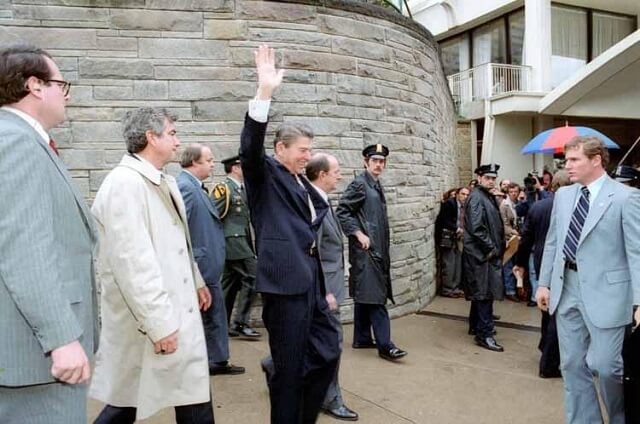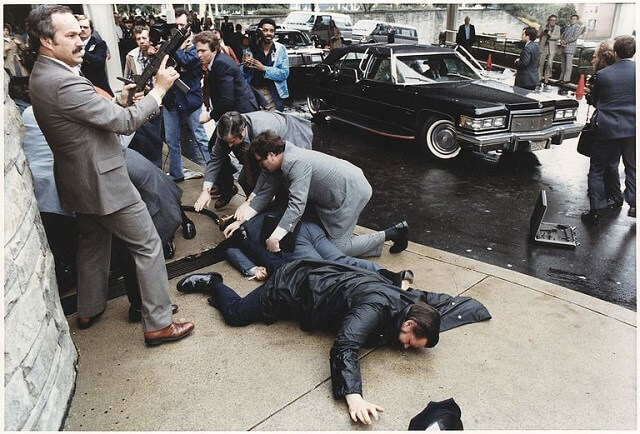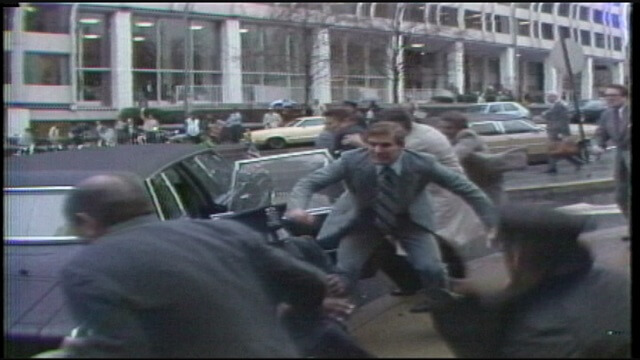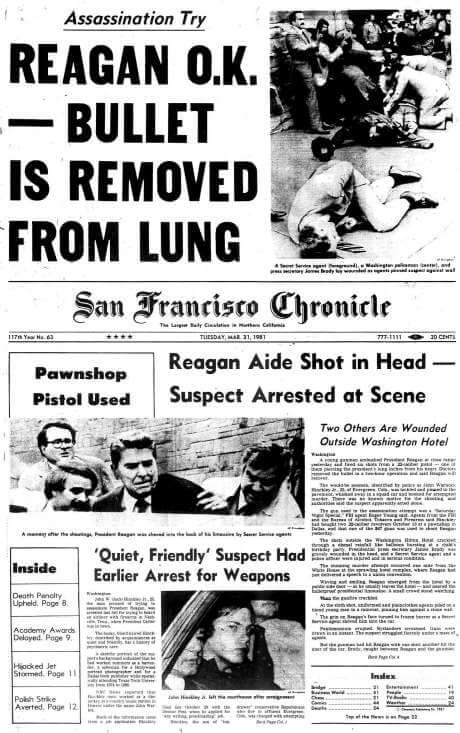The day on which I write this marks the 30th anniversary of the assassination attempt on President Ronald Regan. I thought in honor of this day I would write my memories of Monday, March 30th, 1981.
I was in sixth grade. As far as I know the day started out like any other Monday. It was unremarkable enough that I have no memories of this day up until the time we came back to the classroom after afternoon recess.
I walked in and immediately noticed a television had been wheeled into the room. This was a remarkable sight, as these were the days when a TV in a school room wasn't yet among the standard pieces of learning equipment. The school had a few TVs located in storage closets and available for teachers to check out if there was a reason they needed one. The reasons were few. VCRs weren't yet commonly available (nobody I personally knew had one) so the only viewing option was live programming available via one of the four over the air networks: CBS, NBC, ABC and PBS. In order to use the TV in a classroom, a teacher had to hope a relevant educational TV show was being broadcast during a time that fit the classroom schedule. Needless to say, it didn't happen very often.
The cart was a four wheeled steel beast, painted aqua marine. It had three shelves, with the TV sitting on the top shelf approximately four feet off the ground. The other two shelves were empty, sans a black rubber mat apparently intended to protect the paint on the cart. The TV itself was a standard mid 1970s color model, with a screen size of approximately 19 inches. A rotary knob allowed one of 12 channels to be selected. The top of the TV had a handle giving the deceptive illusion that one could pick up the unit and carry it around. In reality the thing weighed around 80 pounds and probably took two people to hoist it onto the top shelf of the cart. On the back of the TV were two telescopic "rabbit ear" antennas pointing up in the air like a victory sign.
I didn't recall our teacher, Mr. Kelzenburg, saying anything about us watching a TV program after recess, so this caught me off guard. Because of the rarity of the event, we students usually looked upon watching TV in school as a treat, even if it was an educational program that wouldn't interest us outside the school walls. Had we been told that TV was part of the afternoon lesson plan, we would have been buzzing with excitement.
This is why upon entering the room and seeing the TV on was such a surprise. The TV was near the north wall of the room directly opposite of the door to the hallway. This was the place where the TV normally sat when it was brought in to the room. I suspect it was placed in this spot because that is where the signal reception was strongest. Unfortunately in this position it was behind the desks which caused us to have to drag our desks around to face the TV.
Mr. K (which is what everyone called him, although I don't remember that we ever actually called him that to his face) was sitting in a chair, his eyes glued to the screen. As we entered, he motioned for us to drag our desks around to watch the program. Between the fact that it was a news program and the grim look on Mr. K's face, I quickly surmised that something bad had happened.

We gathered around the television and watched the events unfold. The TV was tuned to ABC, and Frank Reynolds was reporting. The details were sketchy, but we quickly learned that around 1:30 PM CST, President Reagan had been shot while leaving a speaking engagement outside the Washington Hilton. There was a lot of confusion, even amongst the reporters as they were trying to piece together the story unfolding before them.

There was a camera present as Reagan left the hotel, which captured the assassination attempt as it happened. This brief few seconds of footage was all the network had to offer outside of the talking heads of reporters and analysts, so we were treated to the same 10 second clip over and over. To add variety, the reporters would play it back in slow motion and stop the footage to speculate on various things happening at that precise moment in time.
As the gunshots sounded, the members of the secret service could be seen covering the President with their bodies attempting to shield him from the rain of bullets. I remember wondering if I found myself in that situation if I would have the presence of mind to willingly sacrifice my life for another person. This was pretty heavy stuff for a sixth grader to contemplate, and after a while I came to the conclusion, "I don't know." It wasn't definite, but it was honest.

At some point, it was announced that both President Reagan and press secretary James Brady had died during the incident. I remember thinking that the "Curse Of Tippecanoe" had just struck: up until President Reagan, every president elected in a year ending in "0" had died while still in office. My mind was spinning with the idea that the president was dead when it then came to light that this was a false report and that the President was still alive but in very serious condition. We got to see Frank Reynolds obviously frustrated with his staff for having him relay such seriously false information over the air.
We watched the television news broadcast for the remainder of the school day despite the fact that there was very little additional information to be learned. There was a little discussion among the class, but for the most part there were no answers to the questions we were asking. I don't remember Mr. K offering much in the way of analysis, or do anything to help us wrap our brains around what was happening. We just sat and stared at the repeated images of the President being thrown into the back of a limo and speeding away.
Later that evening we would learn that President Reagan had suffered a bullet wound which caused a collapsed lung, but had successfully come through surgery and was expected to recover. James Brady, having a shell explode in his head was also expected to live, however his injuries would be much more debilitating.

As for the shooter, we would learn his name was John Hinckley Jr. He was a mentally ill man who apparently had seen the movie "Taxi Driver", and become obsessed with Jodie Foster's role in the film. Relating himself to the character of Travis Bickle, who in the film attempts to assassinate a presidential candidate, Hinckley's deranged mind made him come to the conclusion that he must to the same.
I can remember hearing the news reports of Hinckley's trial, and was surprised when the verdict was finally delivered that he was "not guilty by reason of insanity." This was a confusing verdict for me to wrap my mind around. On one hand I could agree that this guy was seriously disturbed and not thinking correctly. On the other, I reasoned that the same could be argued for most anyone who takes another person's life. Couldn't anyone who kills another in cold blood argue that they are insane? And if they are, how do we justify locking some up and sending others to a hospital? Again it was a difficult subject for a sixth grader to resolve, and once again I came to the conclusion of, "I don't know."
To be honest, I still don't know. But the events of that day remain a permanent fixture in my mind.
Return To The Main Other Gallery
This page last updated on 07/11/2018



